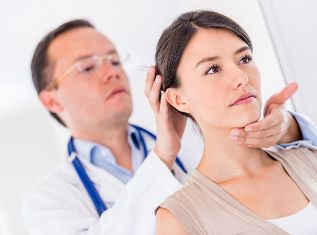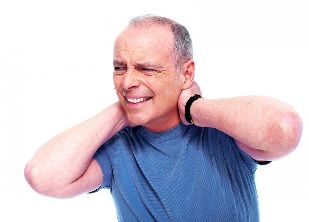Like other back diseases, class 1 cervical osteochondrosis is characterized by the presence of pain. The nature of the pain can be said to be borne, but this does not give a reason to leave the disease without seeking medical treatment and further treatment. Ignoring the symptoms of osteochondrosis, which is still in stage 1, can cause the patient's condition to worsen and the development of the disease.
Self-treatment is not recommended, only experienced doctors can make an accurate diagnosis, determine the cause of the symptoms of the disease and give clear recommendations for dealing with osteochondrosis.
Causes of disease
Against the background of grade 1 osteochondrosis of the cervical spine, first of all, there is a shooting pain, called lumbago. Pain syndrome occurs in the cervical area, in severe cases it spreads to the shoulder, arm and chest muscles. This is because the intervertebral disc tends to be injured to a greater extent where the moving part of the spinal space (cervical area) is connected to the less moving thoracic area.

The cervical region consists of 7 vertebrae. The first two support the skull, which is why one can rotate his head, tilt and raise it. The vertebrae are connected by moving joints and ligaments, and the intervertebral disc, which is made up of cartilage tissue, serves as a spacer between the vertebrae. Adjacent muscles are also designed to keep the spine in an upright position, if the corset muscles are well developed, the spine will be stable. As you can see, the work of vertebrae, intervertebral discs and well-coordinated muscles ensures healthy spinal function. Once a link from this system begins to function, disruption occurs throughout the work of the spine.
For what reasons there are violations and the symptoms of osteochondrosis first appear:
- inactive lifestyle;
- excessive physical activity;
- wrong position during sleep;
- nutrition that does not provide the body with adequate amounts of nutrients that strengthen the bone and muscle systems;
- bad habits;
- pressure;
- lack of rest, fatigue;
- Frequent hypothermia and colds.
If the muscles that support the spinal space in a stable state begin to age and lose tone approaching 50 years - this can be considered normal. But when the cervical vertebrae undergo a process of deformation at the age of 20, it is necessary to observe and take action. Undergo preventive treatment, exercise, lead an active lifestyle, and avoid uncomfortable work with a crooked neck and back.
Symptoms
To list the main signs and symptoms by which one can accurately determine stage 1 cervical osteochondrosis, it is necessary to explain the concept itself.
Grade 1 osteochondrosis is an early stage of the disease, which has so far been characterized only by compaction of cartilage tissue between the vertebral discs. The vertebral column is still in a stable position, but the process in the form of a vertebral hook has grown. Displacement of the disc is minimal, but its outer shell, which is made up of fibrous tissue, begins to decompose, which, if left untreated, can lead to the development of osteochondrosis and even intervertebral hernias.
The main symptoms of cervical spine osteochondrosis:
- pain syndrome begins in the neck area, spreading to the shoulder joints, shoulder blades and chest muscles;
- squeezing the nerve endings causes the appearance of pain in the neck, especially this condition is exacerbated by uncomfortable posture in sleep, at night, the patient after waking up holding his neck in an inappropriate position for a long time because it is impossible to turn his head without pain;
- against the background of nerve root compression, heart syndrome may occur - pain in the pectoral muscles, which a person confuses with pain in the heart (examination does not confirm the presence of cardiac pathology);
- due to vertebral artery syndrome, decreased blood supply to the brain and spinal cord, which provokes headaches, visual disturbances in the form of "flies in front of the eyes", dizziness, pain in the occipital area;
- sleep disorders;
- worried.

Pain syndrome is accompanied by muscle spasms in the affected spinal area. Grade 1 spinal osteochondrosis may not show the symptoms listed, it all depends on the body's sensitivity to pain and the general well-being of the patient.
With constant fatigue, unstable work and stress, any symptoms of this disease can be felt more deeply. Therefore, the first sign of osteochondrosis - shooting pain in the neck, especially after physical exercise or hypothermia - should be the reason for a visit to the doctor.
Treatment and prevention
Class 1 cervical osteochondrosis therapy, first and foremost, should be aimed at eliminating pain syndrome and smoothing active metabolic processes in intervertebral disc tissue. Also, it is important to strengthen the skeletal muscles of the neck to keep the spinal space in a stable and strong position.
Drug therapy involves the following methods:
- painkillers, anti-inflammatory drugs;
- physiotherapy;
- urut;
- acupuncture;
- medical gymnastics;
- swim.
With the help of drug therapy, it is necessary to relieve pain and inflammation in the affected area, in this case, the doctor can combine the appointment of oral anesthetic drugs with vitamin injections, anti-inflammatory drugs. Good effect is given by the use of external agents in the form of gel heating based on painkillers, as well as bee and snake venom.
Supplements to drug therapy and physiotherapy can be therapeutic exercises, which will help stretch the spine gently, freeing the pinched nerve roots and relieving neck pain. The next preventative measures are a healthy, active lifestyle, exercise, good nutrition, as well as avoiding stress and hypothermia.























